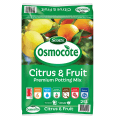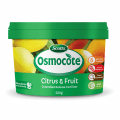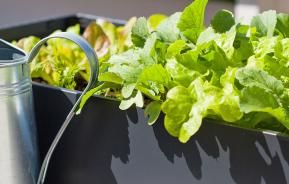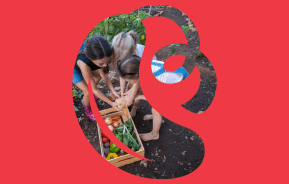
Everything You Need to Know About Stone Fruits & How to Grow Them at Home
Stone fruits are a Summertime favourite, often filling salads, desserts and dishes with their juicy and delicious flavours. Did you know these fantastic warm-weather crops can be produced in our back gardens?
Read on to find out how to grow an abundance of stone fruits at home!
What is a Stone Fruit?
Stone fruits are also called drupes. They're best distinguished from other types of fruit by always having a seed surrounded by a single stone (or 'pit') enclosed by a fleshy pulp. Like most fruits, drupes are a great source of fibre. They're rich in vitamins A, C and E and others are also rich in anthocyanins, iron and potassium too, so be sure to include a mix of stone fruits as part of your balanced, healthy diet.
Stone fruits are generally in season in Australia from November through to April, when the heat helps the fruit to develop its characteristic sweet flavour.
To know when stone fruits are ready for harvest, squeeze them very gently and if you feel a little give, it's time to pick! Another telltale sign of ripeness is the smell - get up close and if you can smell the fruit it's ready for eating. Only pick ones that are ready, as most stone fruits don't ripen once they're taken from the tree.
Types of Stone Fruits
We've created a handy stone fruit list for a wide selection of Australian conditions to help you choose which one to grow at home. With good care, stone fruits will provide you plenty of produce for many years to come.

Peaches
The yellow-red fuzzy skin of peach fruits make this small tree an attractive plant to include in the garden.
Plant out during Winter, when the plant is dormant. Peach trees need a period of cold weather each year, and full sun during the Summer months. Position away from strong winds, and work Scotts Osmocote Fruit & Citrus Controlled Release Fertiliser into the upper surface of the soil to help provide the plant with a full range of helpful nutrients. Water during very dry periods.
Prune during the Winter to an open (goblet) shape that allows good air circulation, in the early years. They can also be fan-trained. Once the mature shape has been established, thin fruit in late Spring so that the branches do not snap from developing too many heavy fruits. Peach fruits can be round or flat like a donut, and start to ripen from November onwards.
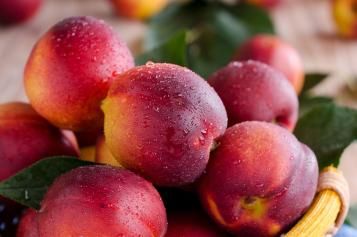
Nectarines
Closely related to the peach, nectarines are their smooth-skinned cousin. The skins are more solidly red, with yellow-orange blushes. They are small trees, rarely reaching above 4m. As with most stone fruit trees, dwarf varieties are available and are great for small spaces or large pots.
You should look after a nectarine plant exactly as you would a peach tree. They will fruit 4 years after they have been planted out and are relatively quick to produce good numbers of nectarines.
There are lots of cultivars available, so if you have the room, try planting a few different ones. ‘Sunraycer’ produces especially large fruits, ‘Sunbob’ is great in cooler areas, and ‘White Satin’ produces white fleshed super sweet fruits.
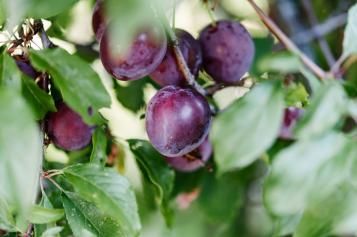
Plums
There are two main types of plum tree to choose from, and which one to grow will depend on your local climate. Varieties of European plum (Prunus domestica) need a spell of cold weather to produce fruits each year, ideally, 700 hours or more where the ground temperature is as low as 0-7C. The other main variety is the Chinese plum (Prunus salicina), suitable for warmer areas where temperatures do not stay that low for long.
Plums have purple, red or yellow skin and are quite varied in size and shape. Unlike many other stone fruits, plums will continue to ripen once picked, and can become quite mushy, so pick them as you need them, from November onwards.
Plum trees like full sun and well-drained, nutrient-rich soil. Winter is the right time to plant them out and to give them a prune to maintain good shape. Use Scotts Osmocote® Plus Organics Citrus & Fruit Plant Food & Soil Improver every 6 months, in early Spring and again in early Autumn.

Apricots
Bright orange apricot fruits are little balls of summery happiness, and a great source of iron too! Apricot trees are real stunners, with the vibrant fruit ready from November onwards, followed by colourful yellow foliage. They are available as small trees, growing to 4m, as well as dwarf varieties which are easier to reach and maintain.
Plant out in the Winter, watering frequently from Spring onwards, until well established. They need plenty of organic matter in the soil, so mix in Scotts Osmocote Plus Organics for Citrus & Fruits with garden soil prior to planting.
Apricot trees are content in neutral soil, although even happier in slightly alkaline ground. Provide with plenty of sun, and protect from strong winds by staking them. Prune straight after they have finished cropping, to maintain good airflow through the plant, as well as remove any dead, diseased or damaged branches.
Mangoes
Good for growing in the ground as medium-sized evergreen trees. They reach 10m (33’) tall, although dwarf cultivars are available and can be grown in pots as smaller plants. Mango trees do not tolerate frost and prefer sub-tropical conditions, so make sure to provide sun, consistent warmth and good access to moisture.
Mangoes can be grown from seed but will take longer to produce fruit. A potted mango plant will have a head start on them. Fruits are green to begin with, turning yellow, orange and red as they ripen. Ripening can take 4-5 months, meaning that they will be ready from mid-Summer onwards, slightly later than many other stone fruits.
Cherries
The red fruits, pink blossom and smooth purple-brown bark of homegrown cherry trees are a joy to see in the garden. The juicy and cheerful bright fruits are full of disease-fighting anthocyanins, as well as providing a good source of potassium. Sweet and sour types are available, and it’s the sweet ones (Prunus avium) that are grown for eating fresh from the fruit bowl.
Cherry trees can reach over 10m (33’) tall if allowed, so prune to maintain shape. Look for dwarf cultivars for shorter types which are easier to manage, or plant in pots to contain their growth. Add nets after flowering and prior to fruit formation, to prevent birds from landing and eating them.


